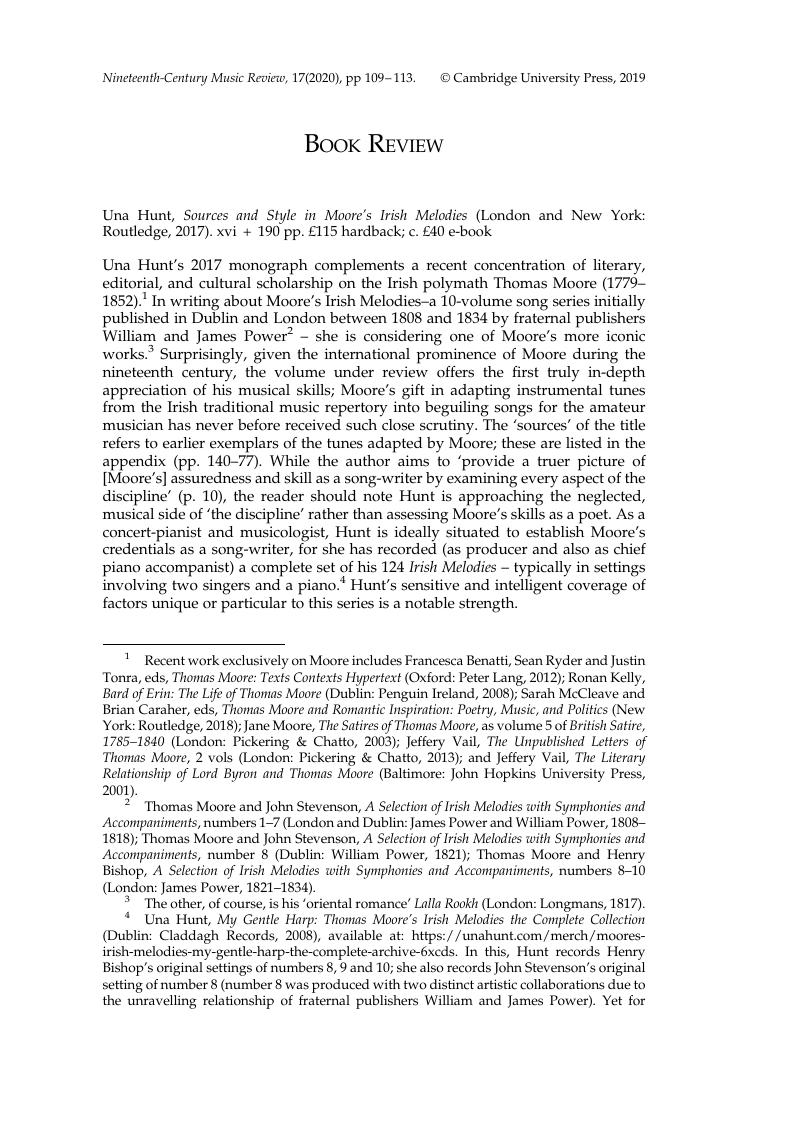No CrossRef data available.
Article contents
Una Hunt, Sources and Style in Moore’s Irish Melodies (London and New York: Routledge, 2017). xvi + 190 pp. £115 hardback; c. £40 e-book
Review products
Published online by Cambridge University Press: 04 March 2019
Abstract

- Type
- Book Reviews
- Information
- Copyright
- Copyright © Cambridge University Press 2019
References
1 Recent work exclusively on Moore includes Benatti, Francesca, Ryder, Sean and Tonra, Justin, eds, Thomas Moore: Texts Contexts Hypertext (Oxford: Peter Lang, 2012); Kelly, Ronan, Bard of Erin: The Life of Thomas Moore (Dublin: Penguin Ireland, 2008); McCleave, Sarah and Caraher, Brian, eds, Thomas Moore and Romantic Inspiration: Poetry, Music, and Politics (New York: Routledge, 2018); Moore, Jane, The Satires of Thomas Moore, as volume 5 of British Satire, 1785–1840 (London: Pickering & Chatto, 2003); Vail, Jeffery, The Unpublished Letters of Thomas Moore, 2 vols (London: Pickering & Chatto, 2013)Google Scholar ; and Vail, Jeffery, The Literary Relationship of Lord Byron and Thomas Moore (Baltimore: John Hopkins University Press, 2001)Google Scholar .
2 Thomas Moore and John Stevenson, A Selection of Irish Melodies with Symphonies and Accompaniments, numbers 1–7 (London and Dublin: James Power and William Power, 1808–1818); Thomas Moore and John Stevenson, A Selection of Irish Melodies with Symphonies and Accompaniments, number 8 (Dublin: William Power, 1821); Thomas Moore and Henry Bishop, A Selection of Irish Melodies with Symphonies and Accompaniments, numbers 8–10 (London: James Power, 1821–1834).
3 The other, of course, is his ‘oriental romance’ Lalla Rookh (London: Longmans, 1817).
4 Hunt, Una, My Gentle Harp: Thomas Moore’s Irish Melodies the Complete Collection (Dublin: Claddagh Records, 2008)Google Scholar , available at: https://unahunt.com/merch/moores-irish-melodies-my-gentle-harp-the-complete-archive-6xcds. In this, Hunt records Henry Bishop’s original settings of numbers 8, 9 and 10; she also records John Stevenson’s original setting of number 8 (number 8 was produced with two distinct artistic collaborations due to the unravelling relationship of fraternal publishers William and James Power). Yet for numbers 1 through 7, she prefers the later arrangements of Moore’s lyrics (published by J.A. Novello of London in 1859) by Michael William Balfe to those by Stevenson.
5 Edward Bunting’s published collections include A General Collection of the Ancient Irish Music (Dublin and London: William Power and James Power, 1796); A General Collection of the Ancient Music of Ireland (London: Clementi & Co., for the Editor, 1809); and The Ancient Music of Ireland (Dublin: Hodges and Smith, 1840). Bunting’s manuscript collection of Irish tunes and lyrics in Irish or English (often collected separately) is available through Special Collections and Archives, Queen’s University Belfast.
6 Cinnéide, Veronica Ní, ‘The Sources of Moore’s Melodies’, Journal of the Royal Society of Antiquities of Ireland, 89/2 (1959): 109–134Google Scholar ; Fleischmann, Aloys, ed., Sources of Irish Traditional Music c.1600–1855, 2 vols (New York: Garland, 1998)Google Scholar . For a table comparing Hunt’s findings with those of Ní Cinnéide and Fleischmann, see pp. 140–77.
7 Zimmermann, Georges-Denis, Songs of Irish Rebellion, Political Street Ballads and Rebel Songs 1780–1900 (Dublin: Allen Figgis, 1967)Google Scholar ; Thuente, Mary Helen, The Harp Re-strung: The United Irishmen and the Rise of Irish Literary Nationalism (New York: Syracuse University Press, 1994)Google Scholar ; White, Harry, The Keeper’s Recital: Music and Cultural History in Ireland, 1770–1970 (Cork: Cork University Press, 1998)Google Scholar .
8 The aisling is a type of Irish poem that recounts a particular kind of vision. As Maria Tymoczko explains, ‘the poet has a vision or dream of a beautiful woman who comes to appeal or lament to him. The woman in the aisling represents Ireland, and her misery is associated with Ireland’s political bondage; she is often portrayed as languishing for her rightful spouse – associated at this period with the exiled Stuart line.’ See Tymoczko, Maria, The Irish Ulysses (Berkeley: University of California Press, 1994), 101Google Scholar .
9 Leerssen, Joep, Remembrance and Imagination: Patterns in the Historical and Literary Representation of Ireland in the Nineteenth Century (Cork: Cork University Press, 1996)Google Scholar ; Tessier, Thérèse, The Bard of Erin: A Study of Moore’s Irish Melodies (Salzburg: Institute für Anglistik und Amerikanistik, Universität Salzburg, 1981)Google Scholar .


